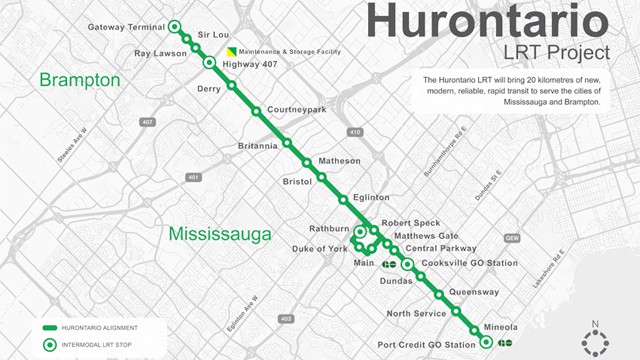Are Small Businesses Prepared for the LRT in Mississauga?
Published August 22, 2017 at 4:40 pm

The mayors of both Mississauga and Brampton laud construction of the Hurontario LRT as an important development for sustainable transit as both cities grow.
The 20 kilometers of dedicated rapid transit through the Hurontario corridor would further link the two cities physically and economically, with 22 stops between Port Credit Go Station in Mississauga and Gateway Terminal in southern Brampton. The idea is to cut travel times and reduce congestion across the GTHA.
While large and medium-sized businesses are enthusiastic, some small businesses say they want to hear more about the project.
Among the parties paying close attention to the LRT’s development is the Port Credit “Business Improvement Area” (BIA), a city-approved association of local businesses which acts as a “self-help program”, allowing them to join together to pay for things like ‘beautification’ of the area to attract customers.
Ellen Timms, General Manager of Port Credit BIA, says while the organization expects short-term “growing pains” from construction, they are thrilled about the LRT.
Timms says the city needs a rapid transit system to make the area more accessible, particularly on weekends.
“It means more people will be able to come to our waterfront, move around, and find jobs.”
The BIA was relieved, Timms said, that the LRT would stop at Port Credit rather than continuing along Lakeshore, which could extend the “growing pains.” The group’s been “very engaged from the very beginning” in communication with the city, as part of an advisory committee, she adds.
She emphasizes that smaller businesses may be less prepared.
“You might walk into a little smoke shop and they might not know anything about it…When we send out information, they may or may not read it.”
Joe Perrotta, Director of the City of Mississauga Hurontario LRT Project Office, said the city will be in consistent communication with residents and businesses to help smooth the way in the lead-up to and during construction slated for late 2018.
“The City of Mississauga is working with Metrolinx…as well as the City of Brampton and the Region of Peel to mitigate the impacts of construction, where practical,” he said.
He adds the city is also looking to other municipalities for inspiration.
“The project team is also working with local councillors, business groups, city departments and other government agencies to apply the best practices from other projects such as the Hanlan Water Project, Eglinton Crosstown and ION LRT in Waterloo.”
As for feedback so far, Perrotta said it has been generally positive and the city will be ramping up its efforts toward a dialogue as the project advances.
Lisa DiMenna, spokesperson for Infrastructure Ontario, says awareness of the project and its impact differs depending on companies’ size.
“Large and medium sized businesses along Hurontario have been very positive about the LRT. Companies are reportedly interested in office space on Hurontario. Awareness appears to be lower among small businesses on the corridor.”
Farid Pourkhatai, spokesperson for Port 1 Café & Gelateria at Hurontario and Lakeshore Rd. E, said more should be done to prepare small businesses for the effects of a new LRT.
“We received a pamphlet indicating the plan; no real preparation though. Not quite sure how the city can prepare us!”
Pourkhatai says he’s watched the development of the Eglinton Crosstown LRT and it’s left him with concerns for his company.
“Just take a look at what businesses along Eglinton (between Yonge and Leslie in Toronto) are going through right now and the same will be experienced by us in 2018. Once completed, things may get better; the property taxes will more likely hike at that time!”
Klaus Northmore, owner of the Works Gourmet Burger Bistro at Lakeshore Rd. E. just west of Hurontario, agrees with Timms that the area needs an LRT for the long-term benefits he believes it will bring to businesses.
However, like Pourkhatai, he wants more proactive communication.
“I have heard nothing really from the City on this. I actually heard about it on the news,” he said.
Ill-preparedness could be costly for small businesses. According to Infrastructure Ontario, “The Hurontario LRT project is being delivered using IO’s Alternative Financing and Procurement (AFP) delivery model. AFP transfers appropriate project risks to the private sector.”
IO’s website describes what can qualify as appropriate project risks:
“There are many potential risks for any complex project in terms of design errors and omissions, unforeseen site conditions, labour and material costs, as well as ongoing maintenance and financial risks. In AFP contracts, many of these risks are transferred to the builder.”
To find and address risks that could impact local businesses, IO said, the team working on the Hurontario LRT project will begin a “Community Connectors” program in November this year.
“Teams of two people will visit every street level address on Hurontario twice per year,” DiMenna said. “During these visits, the Connectors will provide contact information for any questions between visits and work on issues that may arise during construction.”
Hurontario Light Rail Connection Partners (HLCP), Mobilinx and Trillium Transit Partners were all recently short-listed for the LRT project.
The contract is expected to be awarded in 2018, after which the LRT could be completed and useable by 2022.
insauga's Editorial Standards and Policies advertising





